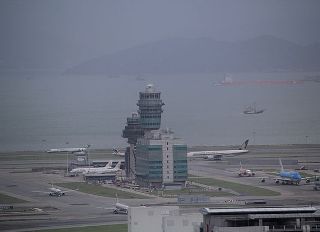 Airport Authority Hong Kong (AA) said it will go ahead with constructing a marine park as the initial part of its proposed expansion plan for the Hong Kong International Airport (HKIA) following government approval of its three-runway system (3RS) project.
Airport Authority Hong Kong (AA) said it will go ahead with constructing a marine park as the initial part of its proposed expansion plan for the Hong Kong International Airport (HKIA) following government approval of its three-runway system (3RS) project.
In a statement, AA said the Director of Environmental Protection has decided to approve its environmental impact assessment report and issue an environmental permit, paving the way for construction of a third runway at HKIA to expand its capacity.
“We are delighted to obtain the EP. It marks a major step in Hong Kong’s pursuit of strengthening its long-term competitiveness and leading aviation hub status,” said Fred Lam, CEO of AA.
“Now that the EP has been granted, the AA will kick-start the marine park proposal by developing a management plan for a 2,400-hectare marine park, as committed to in the EIA report,” he added.
AA will also formulate a detailed marine ecology conservation plan, particularly protecting the Chinese White Dolphins within Hong Kong and Pearl River Estuary waters.
Lam said that the airport is currently operating very close to its maximum capacity. The expansion will allow Hong Kong to meet its long-term air traffic demand.
AA is currently reviewing cost estimates and funding arrangements for the scheme design of the 3RS project. For the next stage, it will submit to the government its recommendation on how to take the project forward and complete other necessary statutory procedures once it obtains approval.
“We target to obtain all the necessary approvals to expand the airport, with the aim of having the 3RS fully operational in 2023,” said Lam.
Asia-Pacific carriers get help from iPhone 6 launch
Meanwhile, International Air Transport Association (IATA) data for global airfreight markets showed an acceleration of demand in September.
Measured by freight tonne kilometers, volumes rose 5.2% compared to September last year, which is 0.8 percentage points ahead of the 4.4% average growth in demand reported for the year-to-date. Capacity grew by 3.8%.
Airlines in Asia-Pacific, North America, Middle East, and Africa all posted strong growth figures (between 5% and 17% above previous-year levels). European airlines, however, saw a decline of 1.6% compared to September 2013, and Latin American airlines reported little difference from 2013 with just 0.3% growth.
Asia-Pacific carriers reported growth of 5.7% compared to September 2013. The region is benefiting from a rebound in trade activity after a slowdown in the first quarter. The release of the iPhone 6 also increased freight shipments from China. Capacity increased 5.6%.
“There were mixed messages in September’s freight performance,” said Tony Tyler, IATA’s director general and CEO.
He said the solid growth for Asia-Pacific airlines is a positive sign given their 40% market share. But the 1.6% decline in demand for European airlines is a worrying trend that “reflects the general uncertainty in the European economy amplified by sanctions resulting from the Ukraine-Russia conflict.”
“Overall, improvements in global business confidence have stagnated—which could mean a bumpy road ahead for air cargo,” he said.
Photo: Katie Chan




